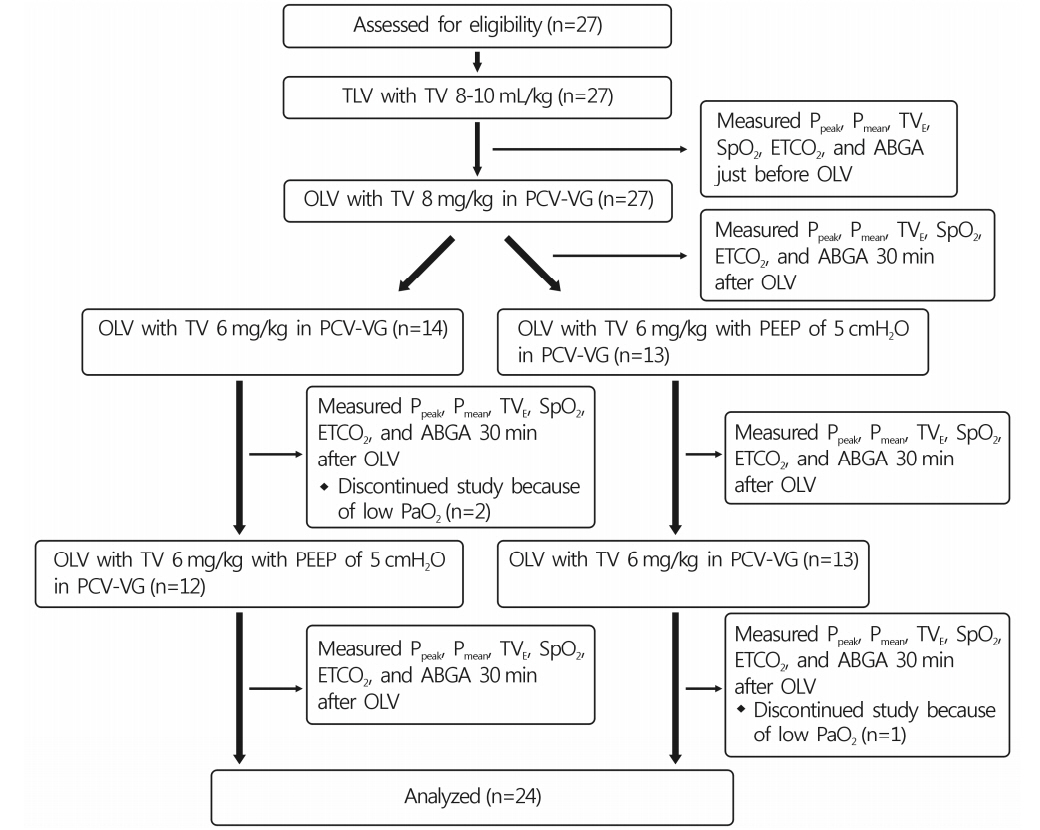Yeungnam Univ J Med.
2018 Dec;35(2):165-170. 10.12701/yujm.2018.35.2.165.
Effects of small tidal volume and positive end-expiratory pressure on oxygenation in pressure-controlled ventilation-volume guaranteed mode during one-lung ventilation
- Affiliations
-
- 1Department of Anesthesiology and Pain Medicine, Catholic University of Daegu School of Medicine, Daegu, Korea. jychung@cu.ac.kr
- KMID: 2433734
- DOI: http://doi.org/10.12701/yujm.2018.35.2.165
Abstract
- BACKGROUND
The purpose of this study was to investigate whether tidal volume (TV) of 8 mL/kg without positive end-expiratory pressure (PEEP) and TV of 6 mL/kg with or without PEEP in pressure-controlled ventilation-volume guaranteed (PCV-VG) mode can maintain arterial oxygenation and decrease inspiratory airway pressure effectively during one-lung ventilation (OLV).
METHODS
The study enrolled 27 patients undergoing thoracic surgery. All patients were ventilated with PCV-VG mode. During OLV, patients were initially ventilated with TV 8 mL/kg (group TV8) without PEEP. Ventilation was subsequently changed to TV 6 mL/kg with PEEP (5 cmHâ‚‚O; group TV6+PEEP) or without (group TV6) in random sequence. Peak inspiratory pressure (P(peak)), mean airway pressure (P(mean)), and arterial blood gas analysis were measured 30 min after changing ventilator settings. Ventilation was then changed once more to add or eliminate PEEP (5 cmHâ‚‚O), while maintaining TV 6 mL/kg. Thirty min after changing ventilator settings, the same parameters were measured once more.
RESULTS
The P(peak) was significantly lower in group TV6 (19.3±.3 cmHâ‚‚O) than in group TV8 (21.8±3.1 cmHâ‚‚O) and group TV6+PEEP (20.1±3.4 cmHâ‚‚O). PaOâ‚‚ was significantly higher in group TV8 (242.5±111.4 mmHg) than in group TV6 (202.1±101.3 mmHg) (p=0.044). There was no significant difference in PaOâ‚‚ between group TV8 and group TV6+PEEP (226.8±121.1 mmHg). However, three patients in group TV6 were dropped from the study because PaOâ‚‚ was lower than 80 mmHg after ventilation.
CONCLUSION
It is postulated that TV 8 mL/kg without PEEP or TV 6 mL/kg with 5 cmHâ‚‚O PEEP in PCV-VG mode during OLV can safely maintain adequate oxygenation.
Keyword
MeSH Terms
Figure
Reference
-
1. Yun du G, Han JI, Kim DY, Kim JH, Kim YJ, Chung RK. Is small tidal volume with low positive end expiratory pressure during one-lung ventilation an effective ventilation method for endoscopic thoracic surgery? Korean J Anesthesiol. 2014; 67:329–33.
Article2. Kim H. Protective strategies for one-lung ventilation. Korean J Anesthesiol. 2014; 67:233–4.
Article3. Jung JD, Kim SH, Yu BS, Kim HJ. Effects of a preemptive alveolar recruitment strategy on arterial oxygenation during one-lung ventilation with different tidal volumes in patients with normal pulmonary function test. Korean J Anesthesiol. 2014; 67:96–102.
Article4. Lee W, Lee JY, Choi DN, Shin CM, Cho K, Kim MH, et al. Airway dimensions and margin of safety with the left-sided double-lumen tube in patients of a short stature. Anesth Pain Med. 2015; 10:110–7.
Article5. Tuğrul M, Camci E, Karadeniz H, Sentürk M, Pembeci K, Akpir K. Comparison of volume controlled with pressure controlled ventilation during one-lung anaesthesia. Br J Anaesth. 1997; 79:306–10.
Article6. Unzueta MC, Casas JI, Moral MV. Pressure-controlled versus volume-controlled ventilation during one-lung ventilation for thoracic surgery. Anesth Analg. 2007; 104:1029–33.
Article7. Boules NS, Ghobrial HZ. Efficiency of the newly introduced ventilatory mode “pressure controlled ventilation-volume guaranteed” in thoracic surgery with one lung ventilation. Egypt J Anaesth. 2011; 27:113–9.
Article8. Pu J, Liu Z, Yang L, Wang Y, Jiang J. Applications of pressure control ventilation volume guaranteed during one-lung ventilation in thoracic surgery. Int J Clin Exp Med. 2014; 7:1094–8.9. Végh T, Juhász M, Szatmári S, Enyedi A, Sessler DI, Szegedi LL, et al. Effects of different tidal volumes for one-lung ventilation on oxygenation with open chest condition and surgical manipulation: a randomised cross-over trial. Minerva Anestesiol. 2013; 79:24–32.10. Keszler M. Volume-targeted ventilation. Early Hum Dev. 2006; 82:811–8.
Article11. Song SY, Jung JY, Cho MS, Kim JH, Ryu TH, Kim BI. Volume-controlled versus pressure-controlled ventilation-volume guaranteed mode during one-lung ventilation. Korean J Anesthesiol. 2014; 67:258–63.
Article12. Gal TJ. Con: low tidal volumes are indicated during one-lung ventilation. Anesth Analg. 2006; 103:271–3.
Article13. Fernández-Pérez ER, Sprung J, Afessa B, Warner DO, Vachon CM, Schroeder DR, et al. Intraoperative ventilator settings and acute lung injury after elective surgery: a nested case control study. Thorax. 2009; 64:121–7.
Article14. Kim SH, Jung KT, An TH. Effects of tidal volume and PEEP on arterial blood gases and pulmonary mechanics during one-lung ventilation. J Anesth. 2012; 26:568–73.
Article
- Full Text Links
- Actions
-
Cited
- CITED
-
- Close
- Share
- Similar articles
-
- Volume-controlled versus pressure-controlled ventilation-volume guaranteed mode during one-lung ventilation
- Comparison of Cardiorespiratory Effects of Pressure Controlled Ventilation with Volume Controlled Ventilation in Severe Respiratory Failure
- Is small tidal volume with low positive end expiratory pressure during one-lung ventilation an effective ventilation method for endoscopic thoracic surgery?
- Change of the Peak Inspiratory Airway Pressure and Exhaled Volume during One Lung Ventilation
- Effects of Intraoperative Ventilation Strategy on Perioperative Atelectasis Assessed by Lung Ultrasonography in Patients Undergoing Open Abdominal Surgery: a Prospective Randomized Controlled Study


